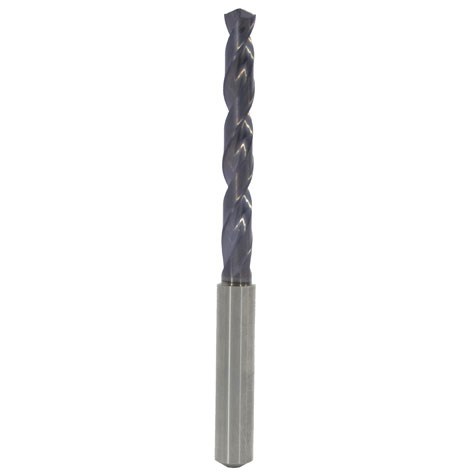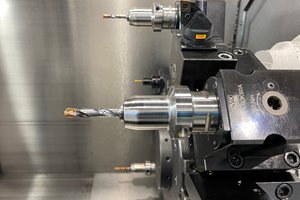How To Machine Composites, Part 4 -- Drilling Composites
Achieving acceptable tool life and hole quality in a material such as CFRP demands a drill designed with composites in mind.
Share





Editors note: This is part four of a five-part series. You can find the links to the entire series below.
Part 1: Understanding Composites
Part 2: The Cutting Tool, Workholding and Machine Tool
Part 3: Milling Composites
Part 4: Drilling Composites
Part 5: Waterjet Cutting
Drilling tends to be the real challenge of machining composite parts. A drill cutting through a metal part simply has to remove the material and clear the hole. By contrast, a drill cutting through a layered composite structure is likely to push the layers ahead of it, producing unacceptable delamination on the exit side.
Earl Wilkerson is CNC programming and tooling supervisor for General Tool, a 240-employee contract manufacturer with considerable composites machining expertise. He equates a standard drill in composites to drilling an unsupported piece of plywood. “A standard metalworking drill would just blow out the back of the hole,” he says. Drilling composites generally requires a tool that is tailored to this work.
One example of a cutting tool company that has developed some tools for composites machining is Onsrud Cutter. For drilling, the range of tool offerings is varied because the range of hole requirements and potential holemaking challenges in composites is so varied. Designs for CFRP drills include:
- Brad-and-spur point designs in which a point centers the tool to let peripheral cutting edges machine like a fly cutter.
- Drill-reamer tools with separate cutting edges for drilling and reaming in one tool.
- An eight-facet point grind that lets the tip’s secondary angles perform a self-seating function. The same design extends life by spreading wear across a larger number of discrete edges.
- Double-margin piloted step drills for close-tolerance holes in composite stacks
Cutting tool supplier Kennametal has also developed tools for composites. Karthik Sampath is a Kennametal research engineer who has studied CFRP drilling. He offers these general points on what makes a tool more effective tool for machining holes in this material:
- Positive geometry is vital to reduce the cutting forces that lead to delamination, he says.
- Helix angle, clearance angle and gash rake angle are all similar in the following respect: As the angle gets larger, hole quality tends to improve.
- A smaller point angle tends to produce better exit quality. However, too small of a point angle can give the tool poor edge strength. For CFRP, the optimal compromise seems to be a point angle of 90 degrees. By comparison, a more typical point angle for drilling metal is 135 degrees (meaning the composites drill is “pointier”).
Mr. Sampath says diamond coating generally delivers 10 times more tool life in CFRP than an uncoated tool. In his experiments, evaluations of various thicknesses of diamond coating, ranging from 5 to 16 microns, suggest that a 12-micron coating delivers the best value in terms of cost vs. tool life.
Hole quality concerns tend to focus on the exit side when drilling composites, but Mr. Sampath notes that problematic hole entry defects are sometimes a concern as well. As the drill enters, it can wind up the top layer of the composite material. He says this problem is typically an indication of too light a feed rate. Entry defects can often be reduced by increasing the feed rate—though this poses the danger of exacerbating exit defects. The optimum feed rate balances quality on both the entry and exit sides.
Mr. Wilkerson of General Tool says that the drill he tends to specify most frequently for his shop’s particular composite parts is the “WonderDrill” from International Carbide Corporation. This tool uses a positive “hook” to draw fibers into the cutting tip for a smooth and clean hole. This simple-looking tool eliminates any excessive fluting to improve strength and rigidity. However, even with this tool, General Tool typically does not rely on drilling to achieve a hole’s final size because the risk of break-out defects is so great. Instead, holes are generally drilled 0.020- to 0.030-inch undersize. Then, a plated diamond finishing tool mills the hole to final size through circular interpolation.
The previous article in this series covered milling. The next article in this series covers one more machining process in composites, waterjet cutting.
Related Content
Tungaloy Drills, Milling Inserts Provide Enhanced Stability
Tungaloy has expanded its DrillForceMeister and TecMill lines with new drill bodies and milling inserts.
Read MoreForm Tapping Improves Tool Life, Costs
Moving from cut tapping to form tapping for a notable application cut tooling costs at Siemens Energy and increased tool life a hundredfold.
Read MoreDarex Adds End Mill Attachment to Drill Sharpener
This LEX600 end mill attachment enables users to sharpen the primary and secondary grind on the tips of two-, three- or four-fluted end mills up to 5/8".
Read MoreCeratizit Product Update Enhances Cutting Tool Solutions
The company has updated its MaxiMill 273-08 face mill, WPC – Change Drill, as well as the HyPower Rough and HyPower Access 4.5-degree hydraulic chucks.
Read MoreRead Next
How To Machine Composites, Part 1 -- Understanding Composites
Composites are replacing metal in certain applications. What does this mean for machining?
Read MoreHow To Machine Composites, Part 2: The Cutting Tool, Workholding and Machine Tool
In carbon fiber reinforced plastic (CFRP), the material removal mechanism is shattering instead of shearing. This makes it different from other machining applications.
Read MoreHow To Machine Composites, Part 3 -- Milling Composites
Diamond shines for this shop when it mills composites.
Read More

.JPG;width=700;quality=80)

.jpg;width=860)
.JPG;width=860)
.JPG;width=860)

















.jpg;maxWidth=300;quality=90)








.jpg;maxWidth=400;quality=70)
.JPG;maxWidth=400;quality=70)
.JPG;maxWidth=400;quality=70)
